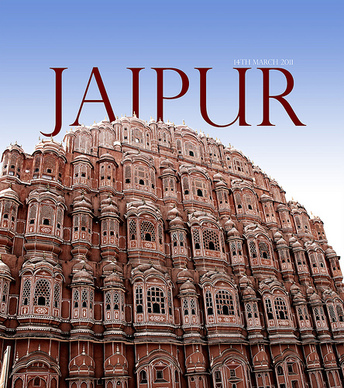
Rajastan's largest City
Anyone who has been to India –specifically Rajastan, the rich and kingly region in the country’s northwest knows that when it comes to adornment Indians have a completely different way of thinking. Families own, for generations, jewellery shops, create astonishingly elaborate jewellery pieces, that one commonly sees in 17th century paintings, enriched with rubies, emeralds, and diamonds that are cut cunningly and glimmer even in candlelight.
Even the camels that swagger slowly along the arrow roadways wear saddles of silver-stitched red cotton.
Singular and memorable in India is colour. No other religion makes use of colour more than Hinduism, the major religion in this multi-faith huge society with over a billion citizens.
Jaipur , approximately 300 kilometres south west of New Delhi is the first and probably finest planned city of India, founded by Maharaja Sawai Jai Singh II and inaugurated November 1727.
Today, the city has a little more than 3.9 million inhabitants.
The business centre on the main street is wide and long studded with all types of shops, and colourful houses.
The city was planned with the grid system in mind and enclosed with a wall. You can walk the entire wall in several hours, but a fraction would suffice to get an idea of the structure and the idea behind it.
The semi-arid climate with hot summers dictates tourists (at least northern hemisphere tourists) to schedule their visit from November to March.
India’s first observatory (Jantar Mantar) and for that matter the first in the world, was erected in Jaipur, the Amber Fort, Hawa Mahal (Palace of the Winds) with five stories, and beautifully designed latticed windows constructed in 1799, Albert Hall Museum, and Jai Mahal (the Water palace), and Lakshmi-Narajan temple are the main sites of Jaipur.
The city has beautiful gardens, parks and the surrounding landscape is enticing for walks to discover less advertised features of this colourful city.
New Delhi, Agra, and Jaipur constitute the so-called “golden” triangle of Indian tourism and Jaipur’s sights are some the most impressive and historied elements.
The massive Fort Jaighat, on the hill, is a tourist must-see structure.
Jaipur is called he Pink City as it was painted in pinkish-red in 1876 in honour of a British royalty visit, but today the original colour is faded and looks less than vibrant and inviting.
Jaipur exports gold, jewellery, has a thriving diamond cutting industry, and a range of small manufacturing base.
Tourists can buy a variety of souvenirs in the numerous shops lining the Main Street, but haggling is highly recommended. Merchants will try to sweet talk gullible tourists to enjoy their hospitality by offering super sweet Indian tea, and then inflate prices. Caveat emptor is the word.
You can reach Jaipur by train from New Delhi (approximately four hours), or rent a taxi, or fly in.
Anyone who has been to India –specifically Rajastan, the rich and kingly region in the country’s northwest knows that when it comes to adornment Indians have a completely different way of thinking. Families own, for generations, jewellery shops, create astonishingly elaborate jewellery pieces, that one commonly sees in 17th century paintings, enriched with rubies, emeralds, and diamonds that are cut cunningly and glimmer even in candlelight.
Even the camels that swagger slowly along the arrow roadways wear saddles of silver-stitched red cotton.
Singular and memorable in India is colour. No other religion makes use of colour more than Hinduism, the major religion in this multi-faith huge society with over a billion citizens.
Jaipur , approximately 300 kilometres south west of New Delhi is the first and probably finest planned city of India, founded by Maharaja Sawai Jai Singh II and inaugurated November 1727.
Today, the city has a little more than 3.9 million inhabitants.
The business centre on the main street is wide and long studded with all types of shops, and colourful houses.
The city was planned with the grid system in mind and enclosed with a wall. You can walk the entire wall in several hours, but a fraction would suffice to get an idea of the structure and the idea behind it.
The semi-arid climate with hot summers dictates tourists (at least northern hemisphere tourists) to schedule their visit from November to March.
India’s first observatory (Jantar Mantar) and for that matter the first in the world, was erected in Jaipur, the Amber Fort, Hawa Mahal (Palace of the Winds) with five stories, and beautifully designed latticed windows constructed in 1799, Albert Hall Museum, and Jai Mahal (the Water palace), and Lakshmi-Narajan temple are the main sites of Jaipur.
The city has beautiful gardens, parks and the surrounding landscape is enticing for walks to discover less advertised features of this colourful city.
New Delhi, Agra, and Jaipur constitute the so-called “golden” triangle of Indian tourism and Jaipur’s sights are some the most impressive and historied elements.
The massive Fort Jaighat, on the hill, is a tourist must-see structure.
Jaipur is called he Pink City as it was painted in pinkish-red in 1876 in honour of a British royalty visit, but today the original colour is faded and looks less than vibrant and inviting.
Jaipur exports gold, jewellery, has a thriving diamond cutting industry, and a range of small manufacturing base.
Tourists can buy a variety of souvenirs in the numerous shops lining the Main Street, but haggling is highly recommended. Merchants will try to sweet talk gullible tourists to enjoy their hospitality by offering super sweet Indian tea, and then inflate prices. Caveat emptor is the word.
You can reach Jaipur by train from New Delhi (approximately four hours), or rent a taxi, or fly in.
 RSS Feed
RSS Feed